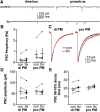Changes in GABAergic Transmission to and Intrinsic Excitability of Gonadotropin-Releasing Hormone (GnRH) Neurons during the Estrous Cycle in Mice
- PMID: 30417076
- PMCID: PMC6223108
- DOI: 10.1523/ENEURO.0171-18.2018
Changes in GABAergic Transmission to and Intrinsic Excitability of Gonadotropin-Releasing Hormone (GnRH) Neurons during the Estrous Cycle in Mice
Abstract
Gonadotropin-releasing hormone (GnRH) neurons form the final common central output pathway controlling fertility and are regulated by steroid feedback. In females, estradiol feedback action varies between negative and positive; negative feedback typically regulates episodic GnRH release whereas positive feedback initiates a surge of GnRH, and subsequently luteinizing hormone (LH) release ultimately triggering ovulation. During the estrous cycle, changes between estradiol negative and positive feedback occur with cycle stage and time of day, with positive feedback in the late afternoon of proestrus in nocturnal species. To test the hypotheses that synaptic and intrinsic properties of GnRH neurons are regulated by cycle stage and time of day, we performed whole-cell patch-clamp studies of GnRH neurons in brain slices from mice at two times considered negative feedback (diestrous PM and proestrous AM) and during positive feedback (proestrous PM). GABAergic transmission can excite GnRH neurons and was higher in cells from proestrous PM mice than cells from proestrous AM mice and approached traditional significance levels relative to cells from diestrous PM mice. Action potential response to current injection was also greater in cells from proestrous PM mice than the other two groups. Interestingly, the hormonal milieu of proestrous AM provided stronger negative feedback on both GnRH neuron excitability and GABAergic postsynaptic current (PSC) amplitude than diestrous PM. These observations demonstrate elements of both synaptic and intrinsic properties of GnRH neurons are regulated in a cycle-dependent manner and provide insight into the neurobiological mechanisms underlying cyclic changes in neuroendocrine function among states of estradiol negative and positive feedback.
Keywords: GABA; GnRH; action potential; estradiol; excitability; feedback.
Figures



Similar articles
-
Changes in Both Neuron Intrinsic Properties and Neurotransmission Are Needed to Drive the Increase in GnRH Neuron Firing Rate during Estradiol-Positive Feedback.J Neurosci. 2019 Mar 13;39(11):2091-2101. doi: 10.1523/JNEUROSCI.2880-18.2019. Epub 2019 Jan 17. J Neurosci. 2019. PMID: 30655354 Free PMC article.
-
Estradiol Increases Glutamate and GABA Neurotransmission into GnRH Neurons via Retrograde NO-Signaling in Proestrous Mice during the Positive Estradiol Feedback Period.eNeuro. 2018 Aug 3;5(4):ENEURO.0057-18.2018. doi: 10.1523/ENEURO.0057-18.2018. eCollection 2018 Jul-Aug. eNeuro. 2018. PMID: 30079374 Free PMC article.
-
GnRH Neuron Activity and Pituitary Response in Estradiol-Induced vs Proestrous Luteinizing Hormone Surges in Female Mice.Endocrinology. 2017 Feb 1;158(2):356-366. doi: 10.1210/en.2016-1771. Endocrinology. 2017. PMID: 27911605 Free PMC article.
-
The neurobiology of preovulatory and estradiol-induced gonadotropin-releasing hormone surges.Endocr Rev. 2010 Aug;31(4):544-77. doi: 10.1210/er.2009-0023. Epub 2010 Mar 17. Endocr Rev. 2010. PMID: 20237240 Free PMC article. Review.
-
A simple model of estrous cycle negative and positive feedback regulation of GnRH secretion.Front Neuroendocrinol. 2020 Apr;57:100837. doi: 10.1016/j.yfrne.2020.100837. Epub 2020 Mar 30. Front Neuroendocrinol. 2020. PMID: 32240664 Review.
Cited by
-
Deficiency of arcuate nucleus kisspeptin results in postpubertal central hypogonadism.Am J Physiol Endocrinol Metab. 2021 Aug 1;321(2):E264-E280. doi: 10.1152/ajpendo.00088.2021. Epub 2021 Jun 28. Am J Physiol Endocrinol Metab. 2021. PMID: 34181485 Free PMC article.
-
The Dopamine D4 Receptor Regulates Gonadotropin-Releasing Hormone Neuron Excitability in Male Mice.eNeuro. 2022 Mar 3;9(2):ENEURO.0461-21.2022. doi: 10.1523/ENEURO.0461-21.2022. Print 2022 Mar-Apr. eNeuro. 2022. PMID: 35165199 Free PMC article.
-
Early-Life Resource Scarcity in Mice Does Not Alter Adult Corticosterone or Preovulatory Luteinizing Hormone Surge Responses to Acute Psychosocial Stress.eNeuro. 2024 Jul 29;11(7):ENEURO.0125-24.2024. doi: 10.1523/ENEURO.0125-24.2024. Print 2024 Jul. eNeuro. 2024. PMID: 39009448 Free PMC article.
-
Increased GABA transmission to GnRH neurons after intrahippocampal kainic acid injection in mice is sex-specific and associated with estrous cycle disruption.Neurobiol Dis. 2022 Oct 1;172:105822. doi: 10.1016/j.nbd.2022.105822. Epub 2022 Jul 20. Neurobiol Dis. 2022. PMID: 35868435 Free PMC article.
-
Gonadal Feedback Alters the Relationship between Action Potentials and Hormone Release in Gonadotropin-Releasing Hormone Neurons in Male Mice.J Neurosci. 2023 Oct 4;43(40):6717-6730. doi: 10.1523/JNEUROSCI.2355-22.2023. Epub 2023 Aug 3. J Neurosci. 2023. PMID: 37536982 Free PMC article.
References
-
- Barrell GK, Moenter SM, Caraty A, Karsch FJ (1992) Seasonal changes of gonadotropin-releasing hormone secretion in the ewe. Biol Reprod 46:1130–1135. - PubMed
-
- Barry PH (1994) JPCalc, a software package for calculating liquid junction potential corrections in patch-clamp, intracellular, epithelial and bilayer measurements and for correcting junction potential measurements. J Neurosci Methods 51:107–116. - PubMed
Publication types
MeSH terms
Substances
Grants and funding
LinkOut - more resources
Full Text Sources
